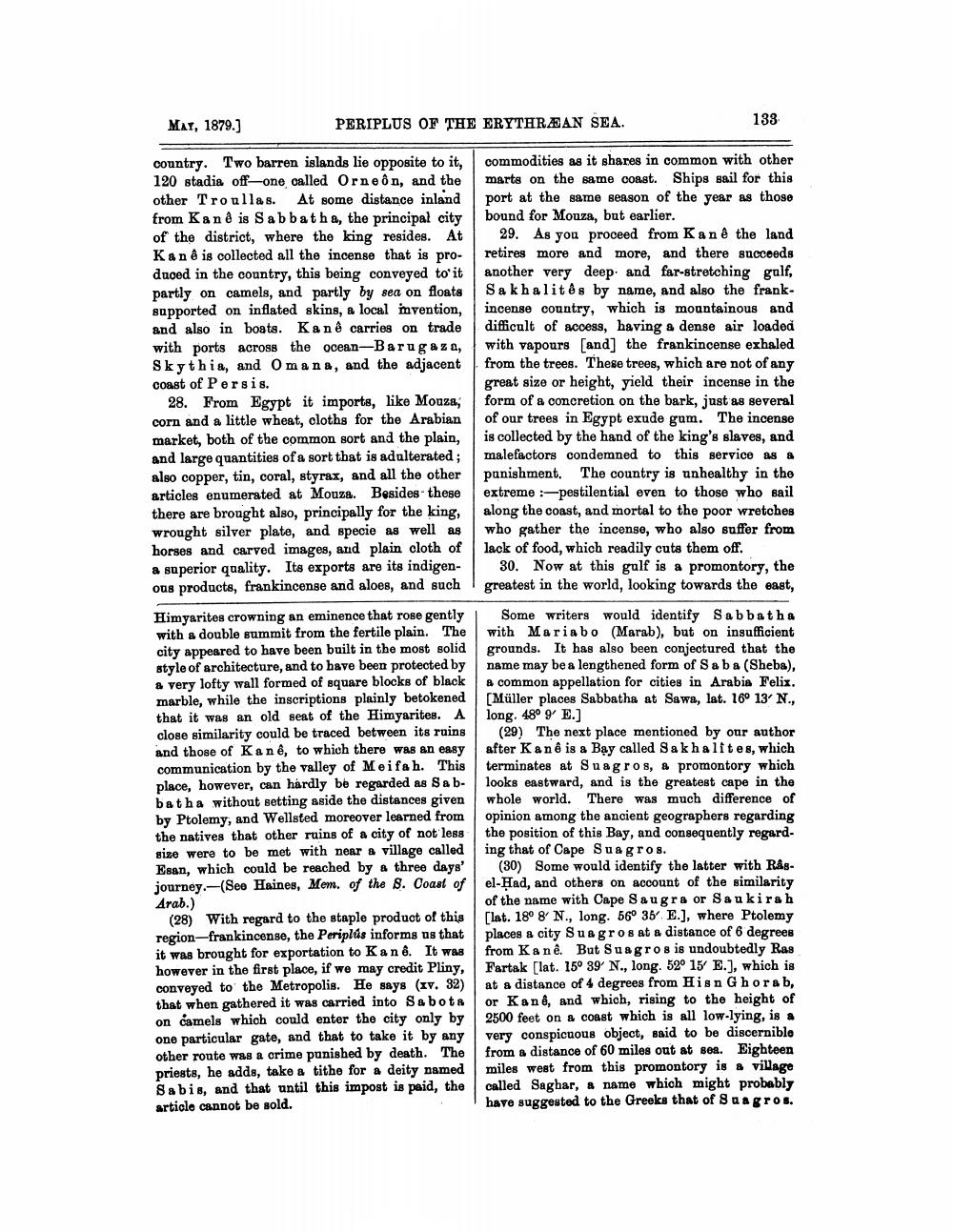________________
PERIPLUS OF THE ERYTHREAN SEA.
MAY, 1879.]
country. Two barren islands lie opposite to it, 120 stadia off-one called Orneôn, and the other Troullas. At some distance inland from Kanê is Sabbatha, the principal city of the district, where the king resides. At Kanê is collected all the incense that is produced in the country, this being conveyed to' it partly on camels, and partly by sea on floats supported on inflated skins, a local invention, and also in boats. Kanê carries on trade with ports across the ocean-Barugaza, Skythia, and Omana, and the adjacent coast of Persis.
28. From Egypt it imports, like Mouza, corn and a little wheat, cloths for the Arabian market, both of the common sort and the plain, and large quantities of a sort that is adulterated; also copper, tin, coral, styrax, and all the other articles enumerated at Mouza. Besides these there are brought also, principally for the king, wrought silver plate, and specie as well as horses and carved images, and plain cloth of a superior quality. Its exports are its indigenous products, frankincense and aloes, and such
Himyarites crowning an eminence that rose gently with a double summit from the fertile plain. The city appeared to have been built in the most solid style of architecture, and to have been protected by a very lofty wall formed of square blocks of black marble, while the inscriptions plainly betokened that it was an old seat of the Himyarites. A close similarity could be traced between its ruins and those of Kanê, to which there was an easy communication by the valley of Meifah. This place, however, can hardly be regarded as Sa bbatha without setting aside the distances given by Ptolemy, and Wellsted moreover learned from the natives that other ruins of a city of not less size were to be met with near a village called Esan, which could be reached by a three days' journey. (See Haines, Mem. of the S. Coast of Arab.)
(28) With regard to the staple product of this region-frankincense, the Periplús informs us that it was brought for exportation to Kanê. It was however in the first place, if we may credit Pliny, conveyed to the Metropolis. He says (xv. 32) that when gathered it was carried into Sabota on camels which could enter the city only by one particular gate, and that to take it by any other route was a crime punished by death. The priests, he adds, take a tithe for a deity named Sabis, and that until this impost is paid, the article cannot be sold.
133
commodities as it shares in common with other marts on the same coast. Ships sail for this port at the same season of the year as those bound for Mouza, but earlier.
29. As you proceed from Kanê the land retires more and more, and there succeeds another very deep and far-stretching gulf, Sakhalitês by name, and also the frankincense country, which is mountainous and difficult of access, having a dense air loaded with vapours [and] the frankincense exhaled from the trees. These trees, which are not of any great size or height, yield their incense in the form of a concretion on the bark, just as several of our trees in Egypt exude gum. The incense is collected by the hand of the king's slaves, and malefactors condemned to this service as a
punishment. The country is unhealthy in the extreme-pestilential even to those who sail along the coast, and mortal to the poor wretches who gather the incense, who also suffer from lack of food, which readily cuts them off.
30. Now at this gulf is a promontory, the greatest in the world, looking towards the east,
Some writers would identify Sabbatha with Mariabo (Marab), but on insufficient grounds. It has also been conjectured that the name may be a lengthened form of Saba (Sheba), a common appellation for cities in Arabia Felix. [Müller places Sabbatha at Sawa, lat. 16° 13′ N., long. 48° 9 E.]
(29) The next place mentioned by our author after Kane is a Bay called Sakhalites, which terminates at Suagros, & promontory which looks eastward, and is the greatest cape in the whole world. There was much difference of opinion among the ancient geographers regarding the position of this Bay, and consequently regarding that of Cape Suagros.
(30) Some would identify the latter with Râsel-Had, and others on account of the similarity of the name with Cape Saugra or Saukirah [lat. 18° 8' N., long. 56° 35 E.], where Ptolemy places a city Suagros at a distance of 6 degrees from Kanê. But Suagros is undoubtedly Ras Fartak [lat. 15° 39′ N., long. 52° 15′ E.], which is at a distance of 4 degrees from Hisn Ghora b, or Kanê, and which, rising to the height of 2500 feet on a coast which is all low-lying, is a very conspicuous object, said to be discernible from a distance of 60 miles out at sea. Eighteen miles west from this promontory is a village called Saghar, a name which might probably have suggested to the Greeks that of Suagros.




